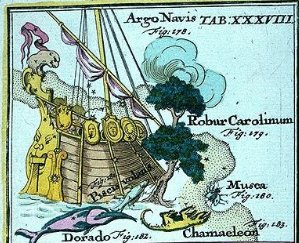4. Possibly one of these 'Lands' of sailable waters was ending in 'May 26 where there is a tagata with a pair of 'eyes' (mata) hanging down as if life-less at left and where the heliacal rising of the star Ain ('Bull's Eye') once would have announced the final of the 'Sea':
In Ga1-1, certainly an important glyph, we can imagine the horns of the Taurus Bull emerging. In addition to the 'painted side boards' in form of dictionaries of etymology we should also make use of the names of the constellations and of their prominent stars. The essence of truth distilled to become myth is furthermore valuable, for instance the myth explainíng why south of the equator the great Cat moves only in the night (cfr at Adjuncts): ... The jaguar learned from the grasshopper that the toad and the rabbit had stolen its fire while it was out hunting, and that they had taken it across the river. While the jaguar was weeping at this, an anteater came along, and the jaguar suggested that they should have an excretory competition. The anteater, however, appropriated the excrement containing raw meat and made the jaguar believe that its own excretions consisted entirely of ants. In order to even things out, the jaguar invited the anteater to a juggling contest, using their eyes removed from the sockets: the anteater's eyes fell back into place, but the jaguar's remained hanging at the top of a tree, and so it became blind. At the request of the anteater, the macuco bird made the jaguar new eyes out of water, and these allowed it to see in the dark. Since that time the jaguar only goes out at night. Having lost fire, it eats meat raw ... To shoot an arrow into the 'navel of the Sea' probably means to 'kill' winter by placing an arrow in its 'eye'. Sticks for creating fire will then come ashore. ... The navel of the ocean was a vast whirlpool in which sticks for making fire by friction were drifting about. At that time men were still without fire. Now the maiden seized her bow, shot into the navel of the ocean, and the material for fire-rubbing sprang ashore ... The shaft of an arrow is a stick. The rays of Sun are like arrows. In May 26 the day number is 146 (= 2 * 73). Easter Island was presumably compared to 'the ashes of Sun' star straight above (Rehua), viz. to Antares at declination 26º 19' S (just north of the latitude of Easter Island, 27º 07' S):
If we should count with a regular solar year of 360 days, then 360 - 146 = 214 (= 2 * 107), and then also 472 - 107 = 365. The latter idea was presented in the Candlemas chapter:
We could read April 10 as the 10th night of the 4th month, and then we could count 10 * 4 = 40, a number possible to see as an allusion to the deluge: "After Noah and the remnant of animals were secured, the fountains of the great deep and the floodgates, or windows, of the heavens were opened, causing rain to fall on the Earth for 960 hours, or 40 days." (Wikipedia) However, the fact that April 10 is day 100 in the Gregorian calendar suggests we maybe instead ought to consider 100 * 4 = 400. In the Candlemas chapter 107 was associated with the number of pages in Manuscript E:
But I was careless. There are 3 pairs of pages among those 100 which have one third cut off. 108 - 2 * (⅓ + ⅓ + ⅓) = 106 (= 2 * 53) and 365 + 106 = 471 (= 1½ * 314). Perhaps there is room for both 107 and 106:
| |||||||||||||||||||||||||||||||||||||||||||||||||||||||||||||||||||



